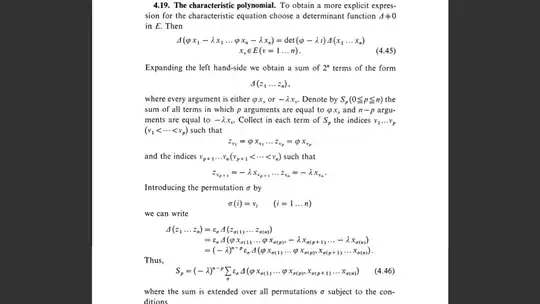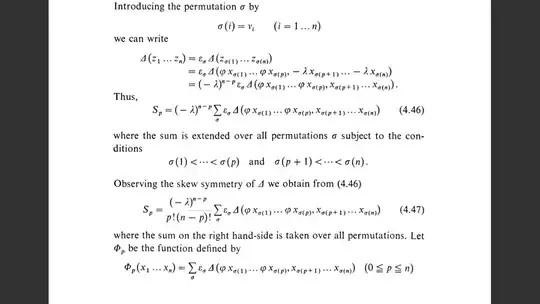Let me write this out in the case $n=2$.
Consider the left hand side of (4.45):
$$\Delta(\phi x_1 - \lambda x_2, \phi x_2 - \lambda x_2)
$$
In the $n \times n$ case, $\Delta$ is an $n$-linear function, as said in the answer of @ChristianBlatter, which means that it is linear separately in each of its $n$ arguments. In this case where $n=2$, that means $\Delta$ is linear separately in each of its $2$ arguments.
As instructed, "Expand the left hand side..."
\begin{align*}
\Delta(\phi x_1 - \lambda x_2,\phi x_2 - \lambda x_2) &= \Delta(\phi x_1,\phi x_2 - \lambda x_2) + \Delta (-\lambda x_2,\phi x_2 - \lambda x_2) \\
(*) \qquad &= \underbrace{\Delta(\phi x_1, \phi x_2)}_{\text{in $S_2$}} + \underbrace{\Delta(\phi x_1,-\lambda x_2) + \Delta(-\lambda x_1,\phi x_2)}_{\text{in $S_1$}} \, + \underbrace{\Delta(-\lambda x_1,-\lambda x_2)}_{\text{in $S_0$}}
\end{align*}
Notice: on the first line, I used linearity of $\Delta$ in its 1st argument; and then, in each of the two $\Delta$ expressions on the right hand side of the first line, I applied linearity of $\Delta$ in its 2nd argument.
Notice, as said,
- "... we obtain a sum of $2^2=4$ terms each of the form
$$\Delta(z_1,z_2)
$$
where every argument [that is, each of the arguments $z_i$ for $i=1,2$] is either $\phi x_1$ or $-\lambda x_1$ ..."
To put this in a wordier manner: in each of the four terms,
the first argument $z_1$ is either $\phi x_1$ or $-\lambda x_1$,
the second argument $z_2$ is either $\phi x_2$ or $-\lambda x_2$.
Now let's see what this says about $S_p$. It says:
- "$S_p$ $(0 \le p \le 2)$ is the sum of terms in which $p$ of the arguments are equal to $\phi x_i$ and $2-p$ of the arguments are equal to $-\lambda x_i$".
In the display above, you will see that I have labelled each of the four terms depending on whether it is in $S_0$, $S_1$, or $S_2$, where:
- $S_0$ is the sum of terms (of $(*)$) in which $0$ of the arguments are are equal to $\phi x_i$ and $2$ of the arguments are equal to $-\lambda x_i$.
- $S_1$ is the sum of terms (of $(*)$) in which $1$ of the arguments is equal to $\phi x_i$ and $1$ of the arguments is equal to $-\lambda x_i$.
- $S_2$ is the sum of terms (of $(*)$) in which $2$ of the arguments are equal to $\phi x_i$ and $0$ of the arguments are equal to $-\lambda x_i$.
And now we can explicitly write them out:
\begin{align*}
S_0 &= \Delta(-\lambda x_1,-\lambda x_2) \\
S_1 &= \Delta(\phi x_1,-\lambda x_2) + \Delta(-\lambda x_1,\phi x_2)\\
S_2 &= \Delta(\phi x_1,\phi x_2)
\end{align*}

